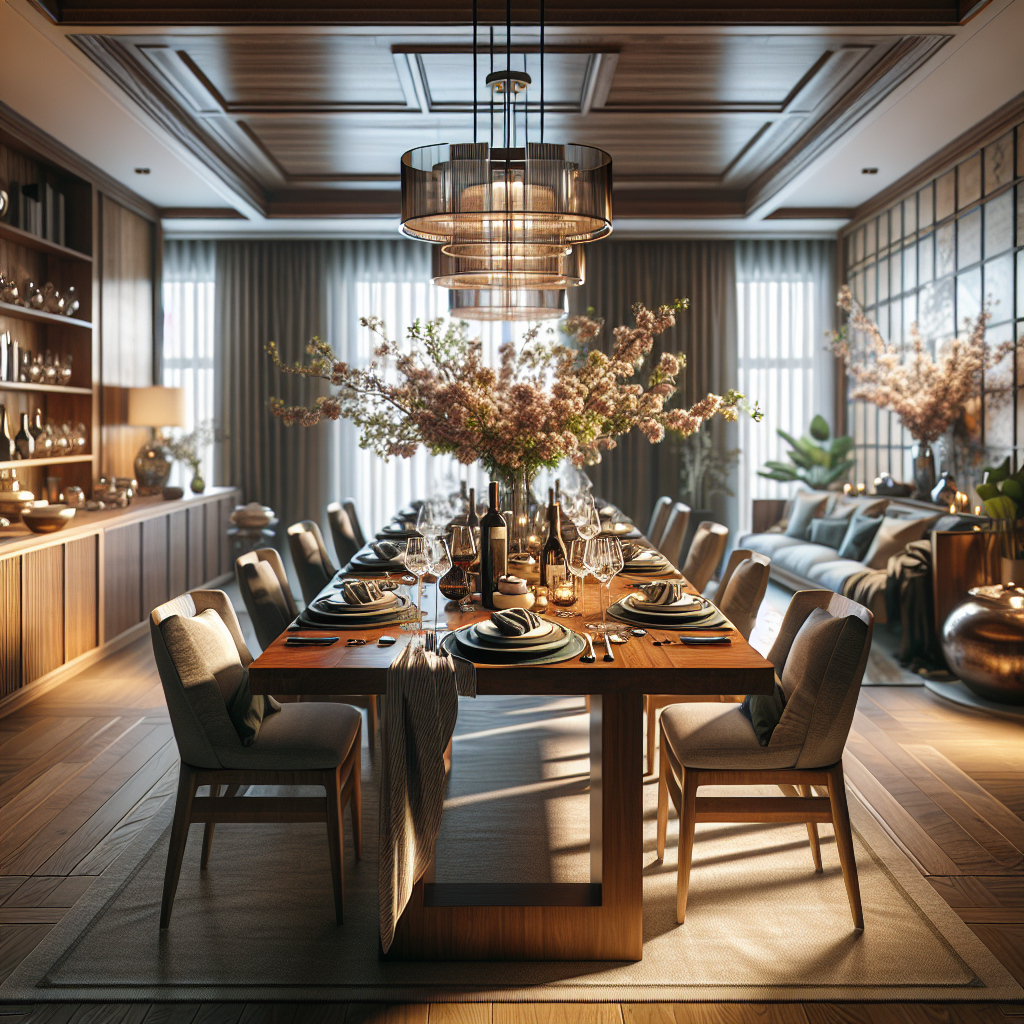Dining Set Essentials: the Key Components
Dining Set Essentials: the Key Components


Dining sets have always been considered the heart of a home. An inviting and well-set dining room table symbolises warmth, camaraderie, and conviviality. But choosing the right dining set is about much more than aesthetics alone. It requires a thorough understanding of the key components, functionality, the space it will take up, and how its style harmonises with the surrounding décor. Whether you're hosting an elegant holiday party, a casual dinner, or enjoying the daily family meal, understanding these components helps ensure that your dining area blends comfort, style, and practicality—giving both your family and guests a dining experience to relish. In this article, we will explore the essential elements that make an ideal dining set, including the dining room table and the layout, along with some handy tips to choose the right components that suit your requirements and taste.
The Main Components of a Dining Set
Every dining set should fulfil a combination of aesthetics, comfort, and function. It starts predominantly with four primary elements: Dining Table, Dining Chairs, Place Settings, and Table Linens. While the dining table set, consisting of a dining table and chairs in various sizes, is the foundation, setting the tone for the overall look, the place settings and linens add to the luxuriousness and contribute significantly to setting the ambience. Each of these elements is available in various styles, sizes, materials, and designs to match your dining space's personality and your lifestyle.
Dining Table
The dining table, the central component of any dining set, sets the stage for the whole dining area's character and functionality. From intimate family dinners to lavish dinner parties, everything revolves around this essential piece of furniture. Selecting a fitting dining table set, which includes a dining table and chairs, requires the consideration of many aspects, such as its shape, size, material, and design.
Dining tables come in various shapes—rectangular, round, square, and oval—each offering different aesthetics and space utilisation. Rectangular tables are popular because they accommodate more people and suit rooms with similar proportions. Round tables foster a sense of intimacy and are ideal for smaller spaces. Square tables aesthetically suit small square rooms, while oval tables offer adaptable seating options with their rounded edges.
The size of the table should correlate with the room's size and the number of diners. As a rule of thumb, allow at least 24 inches of space per person and, for comfort, a minimum of 30 inches between the table and the wall or other furniture.
| Shape | Best Suited for | Advantages |
| Rectangular | Larger spaces, Formal meals | Accommodates more people, suits rooms with similar shape |
| Round | Intimate meals, Small Spaces | Foster closeness, ideal for compact spaces |
| Square | Small square rooms, Casual meals | Unifies everyone equally, suited for small gatherings |
| Oval | Versatile spaces, Various gatherings | Flexible seating, accommodates large groups easily |
Materials range from wood and metal to glass, each offering a unique look. Wood brings a warm, classic feel and is remarkably robust. Metal tables lend a sleek, modern touch, while glass tables create a sense of spaciousness.
Dining Chairs
Dining chairs, which complement the table, are equally essential in shaping your dining area's aesthetic profile and comfort quotient. They dictate the seating quality and impact overall dining experiences, so choosing them requires careful consideration of various factors.
Design and comfort are at the forefront. The chair's design needs to harmonise with your table and other furniture in the dining area. If you desire an eclectic setting, consider mixing and matching chair styles. Piano key-styled chairs or upholstered high-back chairs add a touch of luxury to your dining space. Styling a false fireplace is a great way to add colour and dimension to a dining room - or any other room, for that matter. Adding dining chairs is a great way to complete your dining set and add both style and comfort to your space. For smaller spaces, opt for sleek, armless designs in light colours to make your space feel larger.
Place Settings (Dinnerware, Glassware, Flatware)
Place settings represent the individual dining areas set for each person at the table. They significantly contribute to the functional aspect of your dining set while also enhancing your dining area's visual appeal. A place setting mainly includes dinnerware, flatware, and glassware.
● Dinnerware: The dinnerware, most commonly made of ceramic, porcelain, or stoneware, includes plates (dinner, salad, and bread), bowls (soup or cereal), and other speciality dishes as needed. Depending on your taste and the dining occasion, dinnerware can be plain, patterned, or artfully decorated.
● Glassware: This includes a water glass for every setting, along with wine glasses for formal meals, all placed on the upper right side of the dinner plate.
● Flatware: Flatware refers to eating utensils like forks, knives, and spoons strategically laid out in the order of their use. Directly beside the dinner plate, forks typically go on the left, and knives (with the blade facing the plate) and spoons set to the right.
Table Linens (Tablecloth, Runner, Napkins, Placemats)
Table linens such as tablecloths, runners, napkins, and placemats not only protect your table from spills, stains and scratches but also contribute distinct aesthetics to your dining space.
● Tablecloths: The classic tablecloth covers your entire table, offering protection and a unified look. It provides you with a canvas to play around with other settings and centrepieces.
● Table Runners: For a more modern appeal, consider a table runner. It provides a protective and decorative strip across the width or length of the table, leaving the beauty of the table surface still visible.
● Napkins: Napkins are an everyday essential that can be made to look special. Playing with their folds can add a creative touch to your dining table. Match them with the rest of the table linen, or try contrasting colours for a pop.
● Placemats: Placemats offer an individual setting within the larger table setting. They protect the table directly beneath your plate and flatware and are available in different shapes and materials like woven, cloth, or vinyl.
Factors to Consider when Choosing Dining Set Components
A dining set is a significant addition to your home, requiring an investment of time, money, and thought. Factors such as style and design, size and space, functionality and versatility, and material and durability come into play. Considering each component carefully ensures that your dining set does more than just look good—it becomes an enjoyable, comfortable space where memories are made. Let's delve deeper into these considerations to ensure we choose a dining set that's perfect in all respects.
Style and Design
An important aspect while choosing your dining set is the style and design that complements your home's overall decor. The market presents a plethora of choices, from classic traditional to sleek modern designs and everything in between—rustic farmhouse, French country, industrial, mid-century modern, and more.
The table and chair design set the tone for the entire dining space. For instance, a heavy walnut table and high-back chairs offer a formal, traditional vibe. In contrast, a glass-top table with steel chairs gives off a contemporary feel.
Colour schemes also play a part in setting the mood. Light colours create a calm, spacious feel and are ideal for smaller rooms or areas with limited natural light. Dark colours impart a sense of luxury and intimacy, perfect for larger rooms or homes with high ceilings.
Consider incorporating patterns and textures through upholstery, linens, or even table and chair materials. This can add visual interest and depth to your dining space.
Size and Space
When it comes to choosing dining set components, it is crucial to consider the size of your dining room and how the dining set would fit within that space.
The size of the dining table should be proportionate to your room size and allow enough space around it for easy movement and seating comfort. General guidelines suggest at least 24-30 inches of personal space for each diner and about 48 inches of clearance space around the table to pull out chairs and walk around.
Dimensions
Personal Space for Each Diner: at least 24-30 inches
Clearance Space Around the Table: at least 48 inches
The size and number of chairs depend on the table's size, the regular number of diners, and additional space if you frequently entertain guests. Remember, crowded tables aren't a pleasant dining experience!
Choosing a table appropriate for your space can also have a visual impact. Round or oval tables make a space feel less crowded, while traditional rectangular tables work great in larger spaces.
Finally, as much as we love sideboards, buffets, or bar carts for storage and display, they should not cramp your dining area.
Functionality and Versatility
While style and design are crucial, practicality remains central to your dining set choice. The functionality and versatility of your dining set can directly influence your dining experiences, making meals enjoyable or inconvenient.
For instance, if you often entertain or have larger gatherings, consider an extendable dining table that provides flexibility. Fold-downs or drop-leaf tables can be easily expanded for extra seating. If space is a premium, benches can substitute chairs for a more versatile and casual seating arrangement.
The type of meals also determines the kind of dining set components. For example, formal dining settings demand a more elaborate set-up, so a larger table with armchairs might be preferable. But for casual or hurried meals, a counter-height table with stools might be just as effective.
Remember, functionality extends to the ease of cleaning and maintenance. Opt for easy-to-clean materials, especially if you have children or host parties often.
Material and Durability
Material choice is paramount in determining the durability, look, and feel of your dining set. Factors like climatic conditions where you live, your lifestyle, and tendencies can help narrow down what material suits you best. Here are some popular choices:
● Wood: Classic and durable, wood is a common choice for most homeowners. While hardwoods like oak, maple, and walnut ensure longevity, veneers offer a more budget-friendly option without compromising too much on the quality.
● Metal/Glass: Seek a contemporary appeal with a blend of metal and glass. They are robust, easy to clean, and make your space appear spacious. However, glass tops are prone to scratches and fingerprints.
● Stone/Marble: For a luxurious dining space, consider stone or marble tops. They add a touch of opulence but can be heavy and require maintenance.
● Upholstery: If comfort tops your list, upholstered chairs are a winning bet. However, opt for water and stain-resistant fabrics for easy maintenance.
In terms of durability, look for sturdy construction, solid joints, and quality finishes that promise your dining set can withstand wear and tear.
Choosing the right dining set for your home can be both exciting and overwhelming, given the plethora of options available. The key is striking a balance—one that gracefully merges aesthetics, comfort, and practicality. Remember, the emphasis should not rest solely on style but on how well it harmonises with your lifestyle and the space it is meant to adorn.
Considering elements like the size of your dining area, the number of family members, how often you host, and the kind of meals you enjoy—all these help shape your decision. And, of course, your budget. Investing in a dining set that guarantees durability ensures you get your money's worth over a period of time. After all, an enjoyable, comfortable dining area is much more than just furniture—it is an indispensable part of our homes where memories are created and shared!
